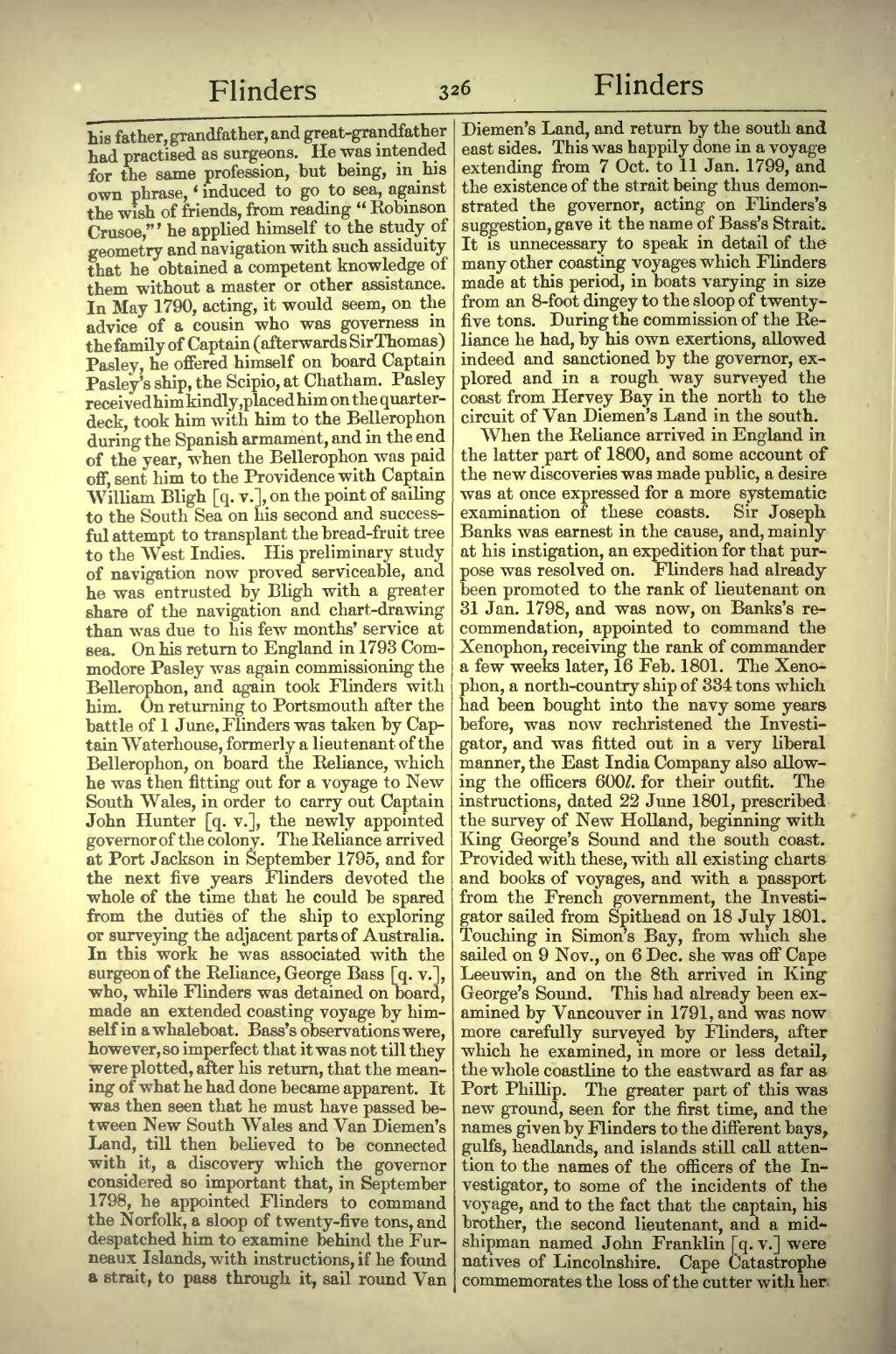his father, grandfather, and great-grandfather had practised as surgeons. He was intended for the same profession, but being, in his own phrase, 'induced to go to sea, against the wish of friends, from reading "Robinson Crusoe,"' he applied himself to the study of geometry and navigation with such assiduity that he obtained a competent knowledge of them without a master or other assistance. In May 1790, acting, it would seem, on the advice of a cousin who was governess in the family of Captain (afterwards Sir Thomas) Pasley, he offered himself on board Captain Pasley's ship, the Scipio, at Chatham. Pasley received him kindly, placed him on the quarter-deck, took him with him to the Bellerophon during the Spanish armament, and in the end of the year, when the Bellerophon was paid off, sent him to the Providence with Captain William Bligh [q. v.], on the point of sailing to the South Sea on his second and successful attempt to transplant the bread-fruit tree to the West Indies. His preliminary study of navigation now proved serviceable, and he was entrusted by Bligh with a greater share of the navigation and chart-drawing than was due to his few months' service at sea. On his return to England in 1793 Commodore Pasley was again commissioning the Bellerophon, and again took Flinders with him. On returning to Portsmouth after the battle of 1 June, Flinders was taken by Captain Waterhouse, formerly a lieutenant of the Bellerophon, on board the Reliance, which he was then fitting out for a voyage to New South Wales, in order to carry out Captain John Hunter [q. v.], the newly appointed governor of the colony. The Reliance arrived at Port Jackson in September 1795, and for the next five years Flinders devoted the whole of the time that he could be spared from the duties of the ship to exploring or surveying the adjacent parts of Australia. In this work he was associated with the surgeon of the Reliancc, George Bass [q. v.], who, while Flinders was detained on board, made an extended coasting voyage by himself in a whaleboat. Bass's observations were, however, so imperfect that it was not till they were plotted, after his return, that the meaning of what he had done became apparent. It was then seen that he must have passed between New South Wales and Van Diemen's Land, till then believed to be connected with it, a discovery which the governor considered so important that, in September 1798, he appointed Flinders to command the Norfolk, a sloop of twenty-five tons, and despatched him to examine behind the Furneaux Islands, with instructions, if he found a strait, to pass through it, sail round Van Diemen's Land, and return by the south and east sides. This was happily done in a voyage extending from 7 Oct. to 11 Jan. 1799, and the existence of the strait being thus demonstrated the governor, acting on Flinder's suggestion, gave it the name of Bass's Strait. It is unnecessary to speak in detail of the many other coasting voyages which Flinders made at this period, in boats varying in size from an 8-foot dingey to the sloop of twenty-five tons. During the commission of the Reliance he had, by his own exertions, allowed indeed and sanctioned by the governor, explored and in a rough way surveyed the coast from Hervey Bay in the north to the circuit of Van Diemen's Land in the south.
When the Reliance arrived in England in the latter part of 1800, and some account of the new discoveries was made public, a desire was at once expressed for a more systematic examination of these coasts. Sir Joseph Banks was earnest in the cause, and, mainly at his instigation, an expedition for that purpose was resolved on. Flinders had already been promoted to the rank of lieutenant on 31 Jan. 1798, and was now, on Banks's recommendation, appointed to command the Xenophon, receiving the rank of commander a few weeks later, 16 Feb. 1801. The Xenophon, a north-country ship of 334 tons which had been bought into the navy some years before was now rechristened the Investigator, and was fitted out in a very liberal manner, the East India Company also allowing the officers 600l. for their outfit. The instructions, dated 22 June 1801, prescribed the survey of New Holland, beginning with King George's Sound and the south coast. Provided with these, with all existing charts and books of voyages, and with a passport from the French government, the Investigator sailed from Spithead on 18 July 1801. Touching in Simons Bay, from which she sailed on 9 Nov., on 6 Dec. she was off Cape Leeuwin, and on the 8th arrived in King George's Sound. This had already been examined by Vancouver in 1791, and was now more carefully surveyed by Flinders, after which he examined, in more or less detail, the whole coastline to the eastward as far as Port Phillip. The greater part of this was new ground, seen for the first time, and the names given by Flinders to the different bays, gulfs, headlands, and islands still call attention to the names of the officers of the Investigator, to some of the incidents of the voyage, and to the fact that the captain, his brother, the second lieutenant, and a midshipman named John Franklin [q. v.] were natives of Lincolnshire. Cape Catastrophe commemorates the loss of the cutter with her
